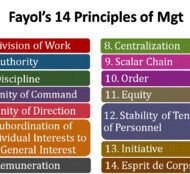Posted by Managementguru in Business Management, Human Resource, Organisational behaviour, Principles of Management
on Mar 10th, 2014 | 0 comments

Line and Staff Authority LINE AUTHORITY: It is that authority which a superior exercises over his subordinates to accomplish primary objectives of the organization. The superior issues orders and instructions to his sub ordinates to complete the tasks. This authority is delegated to those positions or elements of the organization which have direct responsibility for accomplishing the primary enterprise objectives. The flow of authority is always in the downward direction from the superior to the subordinate and such relationship is called LINE RELATIONSHIP that exists in all departments of an organization. ROLES OF THE LINE RELATIONSHIP: 1. As a Chain of Command: Line officials are in the chain of command from the highest position to the lowest position in the organization. Each successive manager exercises command over his subordinates. 2. As a career of accountability: Each executive in the line is accountable for the proper performance of the tasks assigned to him and every subordinate is answerable to his superior. 3. As a Channel of communication: Since the line relationship involves issue of instructions from the authorities and reporting from subordinates, it facilitates and serves as an effective channel of communication. Line relationship helps the organization to work properly by Providing the decisions required for functioning Furnishing reference points for the approval of proposals Serving as a means of control by setting the limits of authority Establishing authentic communication channels to make leadership process effective STAFF AUTHORITY: Literally staff implies a stick carried in the hand for support. In the context of management, it implies to those elements that help the line authorities to function effectively in accomplishing the primary objectives of the enterprise. Staff provides advice assistance and information to line managers and they are distinguished into three categories namely, personal, specialized and general staff. They reduce the burden of line authorities and they too have the right to command and extract work from their subordinates. According to Henri Fayol “staff is an adjunct, reinforcement and a sort of extension of line manager’s personality.” LINE AND STAFF CONFLICTS: As always, functional and decisional conflicts arise between line and staff members. The causes may be attributed to the following reasons. 1. Line managers grudge against the staff personnel: a) The staff authorities try to encroach upon the line managers and tell them how to do their work b) Lack of well balanced advice from the staff managers c) Staff managers are not directly accountable and sport a jealous attitude towards line authorities d) Staff managers fail to see the big picture objectively and their interests are confined to specified situations e) Staff often tend to impose their superiority on line managers 2. Staff personnel complaints against the line managers a) Line managers don’t want to listen to the suggestions of the staff and make it a point to resist new ideas. b) Lack of authority on the part of staff managers to implement their innovative ideas and hence the dependence on line authorities. c) Line managers do not utilize the services of staff personnel properly and effectively. 3. The workers’ attitude a) The authority relationships between line and staff specialists are not clearly defined most of the time b) The basic difference in attitude and perception of the line and staff managers create difficulties for the work force in carrying out orders and...

Posted by Managementguru in Business Management, Principles of Management
on Feb 25th, 2014 | 0 comments

Evolution of Management Theory -II MANAGEMENT PROCESS SCHOOL Henri Fayol (1841-1925) Henri Fayol has propagated 14 principles on management which are very popular. 1. Division of labor: He insists on a high degree of specialization in order to improve efficiency. Both managerial and technical works are amenable to specialization which leads to better work with the same efforts. 2. Authority and Responsibility: Authority can be classified into Official and Personal authority, the former needed by a manager to extract work from the subordinates and the latter emanating from the manager’s own intelligence, integrity, experience, personality, knowledge and skills. Responsibility comes along with authority; one who has the authority should also be able to take up responsibility. 3. Discipline: Obedience, diligence, correct attitude and outward mark of respect is the essence of discipline which exists as an unwritten agreement between the management and its employees 4. Unity of Command: A subordinate must receive orders and instructions from one superior only. 5. Unity of Direction: Activities of similar nature should be grouped under one superior so that the efforts could be streamlined towards the common goal. 6. Sub-ordination of individual’s interest to the Common Goal: The personal interests of an individual (like money, recognition etc.) should not be placed before the goal of the organization, which is maximizing production. 7. Remuneration: Fair and equitable remuneration should be provided to employees to ensure better production and satisfaction. 8. Centralization: The concentration and dispersal of authority must be balanced in an organization 9. Scalar Chain: The authority chain from top to bottom should be followed at all times for the purpose of effective communication. 10. Order: Human and material resources should be co-ordinated so as to be in the required place at the required time. 11. Equity: Fairplay, justice and friendliness is what the employees expect of the organization. 12. Stability of Tenure of Personnel: Too much of Job turn over and rotation affect the work in progress and destruct the stability of the work units 13. Initiative: Subordinates must be encouraged to participate in the decision making process to show their initiative. 14. Espirit De Corps: “In union there is strength and so is team work.” Team spirit and a sense of unity and togetherness should be fostered and administered in an organization. Join Over 290+ Other Entrepreneurs Who Are Using This Course. Become An Outsourcing Master In 30 Minutes James D.Mooney and Allen C.Reilay The Line and the Staff Principle: According to this principle, the line authorities get things done while it recognizes the role of staff authority who are experts in providing guidance and advice. The emphasis is on, · Hierarchial structure · Clear decision · Delegation of Authority and Responsibility · Specialization of Tasks · Co-ordination of activities and · Utilization of staff experts A short course designed to help managers select the right person to join their team! Staff Recruitment THE HUMAN RELATIONS SCHOOL The human behaviorists believed in COLLABORATIVE management which is possible when managers are capable of harmonizing the efforts of individuals at all levels of the organization. This concept draws heavily from psychology and social psychology. · Motivation · Leadership · Communication · Training · Participative management · Group dynamics are assigned importance The important contributors are Elton Mayo, Roethlisberger, Mary Parker Follet, Chester I Bernard, Abraham Maslow and Douglas McGregar. THE EMPIRICAL SCHOOL Case study analogy is the best way to understand management is the idea behind this school of thought. The mistakes of managers are converted into rich experiences over a period of time and the findings are transferred to the practitioners in the management profession. The contributors are, · American Management Association · Harvard Business School · Ernest Dale. However, critics feel that this may not be suitable when it...

Posted by Managementguru in Business Management, Human Resource, Principles of Management
on Feb 15th, 2014 | 0 comments

It all began with ADAM SMITH (1776), the Scottish economist when he lashed out against the abuses of monopoly and mercantilism. He highlighted that productivity was a result of specialization, division of work and exchange. We witness the evidence of managerial practices right from the Sumerian age as early as 5000 B.C., from their written records to administer the governmental and commercial activities. Koutilys’a ARTHASASTHRA and Thiruvalluvar’s THIRUKKURAL have spelt out management principles in a coherent way that suits any time period. MILESTONES IN THE DEVELOPMENT OF MANAGEMENT THOUGHT: 5000 B.C SUMERIANS RECORD KEEPING 4000 B.C EGYPTIANS PLANNING,ORGANISING AND CONTROLLING 500 B.C GREEKS SPECIALISATION 1800 ELI WHITNEY MASS PRODUCTION MADE POSSIBLE 1822 CHARLES BABBAGE PRODUCED DIFFERENCE MACHINE,A FORERUNNER OF TODAY’S COMPUTER 1911 F.W.TAYLOR SCIENTIFIC MANAGEMENT 1916 HENRI FAYOL MANAGEMENT FUNCTIONS 1943 ABRAHAM MASLOW MOTIVATION MODEL 1954 PETER DRUCKER POPULARISED MBO-MANAGEMENT BY OBJECTIVES 1961 RENSIS LIKERT CONTINGENCY LEADERSHIP PRE-SCIENTIFIC MANAGEMENT SCHOOL Management is as old as civilization and it is a separate entity by itself. The full boom of management was witnessed with the advent of INDUSTRIAL REVOLUTION in Europe in the late 18th century. There was mass exodus of people to urban cities in search of jobs due to mechanisation and there arose a necessity to manage people. Initially they were treated as slaves by the owners but later the link factor called “Managers” came into the picture to negotiate and solve issues between the union and management. Important contributors to the management theories Robert Owen: He introduced a system of open rating for workers’ work on a daily basis. He insisted that improving the lives of the working individuals through labor welfare measures was the only way to increase productivity. Charles Babbage: He was a visionary who could foresee scientific management. His difference engine or the modern day computer has made people’s lives easy and has replaced manual operations with machines. Captain Henry Metcalfe: He formed the Bureau of Personal Administration in New York Introduced time cards and material cards Fredrick Winslow Taylor: Founder of scientific management and is called the “Father of scientific management.” He emphasized on the need for management planning and standardization of tools and materials, the former to gauge the capability of men and machine and the latter to save time and increase productivity. He was one of the founders of “Time and Motion study.” His theory was based on the following assumptions: · Production planning and control is the main function of an organization · Insisted on functional foremanship · Time study as the basis for arriving standard time · Standardisation of all tools and parts · The use of ‘slide-rules’ and similar time saving implements · Inroduced ‘time-cards’ for workmen · The ‘differential rate system of wages Henry Gantt: He proposed the Gantt Chart, a visual method to compare production output with time it took to complete a task. This is considered to be a forerunner of today’s PERT-PROGRAMME EVALUATION and REVIEW TECHNIQUE). He also developed · Work quota systems · Bonus systems for workers or managers Objectives of Scientific Management · To ensure continuous employment opportunities for the work force · To gauge market tendencies · To render workers a high standard of living; this motivates them to contribute more · To increase the income of the workers · To assure a socially agreeable condition of working environment · Proper selection, training, assignment, transfer and promotion of workers · To develop self-confidence and self-respect among workers through opportunity and participation · To promote justice through elimination of discrimination in wage-rates · To eliminate causes of friction and to promote understanding, tolerance and the spirit of team-work-Espirit de...






